The flavor of Chinese steamed fish is out of this world.
That is why my family likes to set out on a gourmet trip to fishing villages to savor the spectacular flavor of the perfectly steamed fish.
The texture is tender, the meat tastes like crabmeat, and the sauce is of divine quality.
Tempting to try?
OK. Here is the exact recipe of what we ate at the humble fishing village that is fit for the king.
All you need is to follow the seven simples steps, and you will have a fantastic meal in your comfy home, just like what we had at the fishing hut of the village.
Note: This post may contain affiliate links. Please read my privacy policy for more info. I may receive commissions for purchases made through links in this post. As an Amazon Associate, I earn from qualifying purchases.
What equipment do you need to steam fish?
- A wok with cover (Buy one if you do not. You can use it to cook nearly everything.)
- A steamer rack for wok (If you do not have it, you can place two chopsticks parallel to each other in the wok above the water to support the plate. However, it may not be very stable)
- An oval shape stainless steel plate (Metal is excellent heat conductor and is best for steaming fish. If not, just use whatever ceramic plate you have in your kitchen.)
That is all you need. It is simple.
Now check your kitchen cabinet. Make sure you have all the ingredients in the recipe. Get any items that are not available and get the freshest possible fish that your fishmonger can offer to you.
Now follow the four simple steps to dish out the best possible Chinese steamed fish ever on your dinner table in less than 30 minutes.
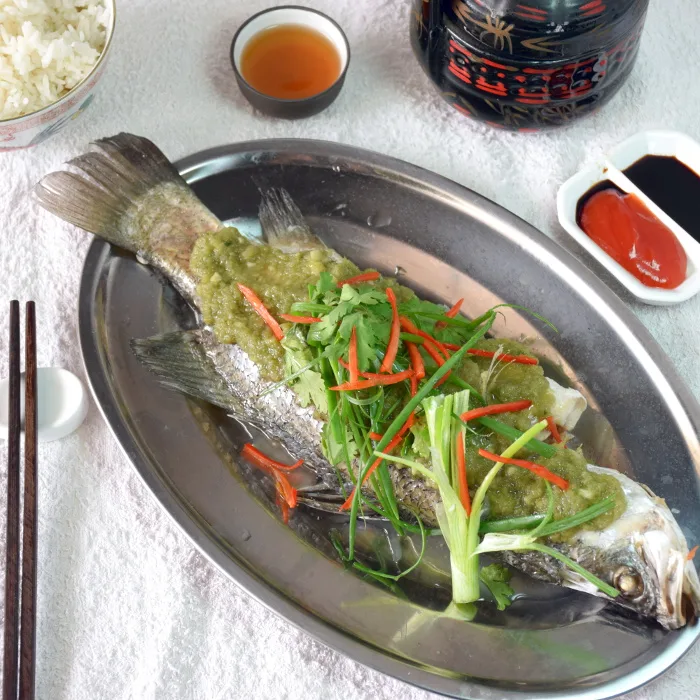
7 steps to steam fish with simple ingredients
(with step by step instruction and images)
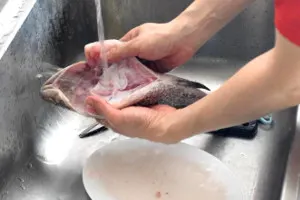
Step 1- Clean the fish
- The fish should be gutted and descaled by your fish vendor. Clean the cavity of the fish thoroughly (make sure no more debris and any fish blood that has a stinky smell)
- Note: You can use fish fillets as the substitute, although most Chinese prefer to steam the whole fish like sea bass. red snapper or any other white fish.
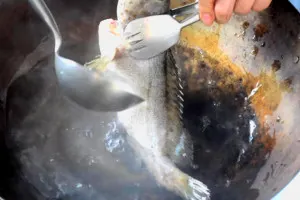
Step 2- Pour hot water over the fish
- Pour some hot water over the entire fish with a ladle a few times. (This is to remove the fishy smell and the slimy coating on the fish if any. )
- Use some paper towels to pat dry.
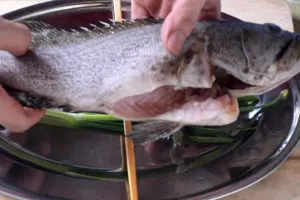
Step 3- Prepare for steaming
- Bring the water in a large wok to a boil.
- Place a stalk of spring onion (green onions) on the plate, and one chopstick (or a metal spoon) at the middle of the plate.
- Place the fish on top of the chopstick (This is to create space between the fish and the plate to ensure even cooking by the steam.) Otherwise, the thickest part of the fish might not be fully cooked.
- Apply some rice wine to the fish (optional, but that is what most chefs in Chinese restaurants do.)
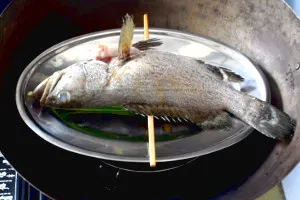
Step 4- Steam for 8 minutes
- Place a steamer in the wok with at least an inch deep of water. (Make sure there is enough water). If you do not have a steamer, just use two chopsticks to support the plate.
- Put the plate of fish on the steamer. Steam over medium-high heat, lid-on, unopeded for 8 minutes. (Refer to the note section below for exact timing,)

Step 5- Blend the ingredients to make the sauce
Blend the ginger, shallots, spring onions, and bird’s eye chili with an electric blender.
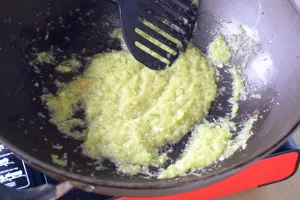
Step 6- Saute and cook the sauce
- Add Ingredients blended ingredients to the sauteed garlic.
- Add the seasoning to it and cook for 1 minute.
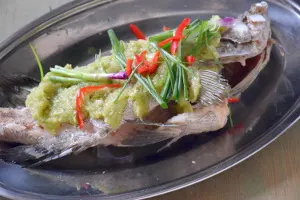
Step 7- Assemble and garnish
- Spread the ginger paste on top of the fish.
- Garnish with spring onions and chili.
- Pour a tablespoon of hot oil in a small saucepan, then pour onto the fish and let it sizzles. Serve
You may like the following items:
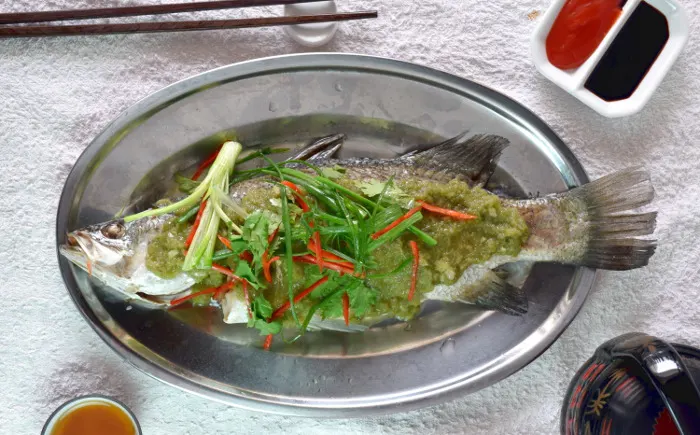

Chinese steamed fish with ginger paste
This recipe is the basic Chinese steamed fish recipe.
Ingredients
Ingredients (A)
- 1 whole fish of 600g, sea bass or your choice of fish
- 2 stalks of spring onions
- 1/2 piece red chili, cut into fine strips
- 3 slices of young ginger, cut into fine julienne
- 10 ml Shaoxing wine
Ingredients (B)- to blend
- 100 g of young ginger
- 15 g of shallots
- 10 g of spring onions
- 2 bird's eye chili
Ingredients (C)- to saute
- 1 tablespoon vegetable oil
- 1 teaspoon chopped garlic
Ingredients (D)- to season ginger paste
- 1 1/2 teaspoon light soy sauce
- 1 teaspoon sesame oil
- 1/2 teaspoon cornflour
- 1/2 teaspoon of salt
- 1 teaspoon sugar
Instructions
- The fish should be gutted and descaled (by your fish vendor)
- Clean the fish cavity thoroughly (make sure not more debris and any fish blood that has a stinky smell)
- Pour some hot water over the entire fish with a ladle a few time.
- Bring the water in the wok to a boil.
- Place a stalk of spring onion on the plate, and one chopstick (or a metal spoon) at the middle of the plate.
- Place the fish on top of the chopstick.
- Apply some Shaoxing wine to the fish.
- Steam over HIGH HEAT, LID-ON, UNOPENED for 8 minutes. (Refer to the note section below for exact timing,)
- Discard the water in the plate after steaming.
- Blend ingredients (B)
- Saute ingredients (C) in a pan.
- Add Ingredients (B) and (D) it the pan. Combined and cook for 1 minute.
- Spread the ginger paste on the fish. Garnish with spring onions and chili.
Recommended Products
As an Amazon Associate and member of other affiliate programs, I earn from qualifying purchases.
Nutrition Information:
Yield: 1 Serving Size: 1 fishAmount Per Serving: Calories: 875Sodium: 3.5mgCarbohydrates: 41gSugar: 17gProtein: 146g
4 Authentic Chinese steamed fish recipes with unique flavor
Here are four authentic Malaysian Chinese ways to steam fish if you like Chinese cuisine.
- Steamed fish with ginger paste 姜蓉蒸鱼
- Chinese Steamed fish with light soy sauce 清蒸鱼
- Steamed fish Teochew style 潮州蒸鱼
- Steamed fish with spicy soybean sauce 酱蒸鱼
You should be able to guess that the character 蒸 means steam and 鱼 means fish by looking at the name of these dishes 🙂
We use the same steaming method to prepare these dishes. The different flavor of these recipes is mainly due to the choice of ingredients in each recipe.
The most popular style of steamed fish in Malaysia
Steamed fish with ginger paste 姜蓉蒸鱼
The locals like steamed fish with ginger paste, as ginger can remove any unpleasant smell of the fish. Ginger is the primary ingredient in this recipe. You may encounter some other steam with ginger paste recipes that are yellow instead of greenish. The green color of the ginger paste is because of the inclusion of spring onions and green bird’s eye chili. You can omit the spring onions to obtain the classic yellow color and rely on the spring onions topping for the flavor. The similar ginger paste from China and Hong Kong does not include chili. People who stay in South-East Asia like to add bird’s eye chili into a wide variety of dishes, including steamed fish.
Chinese Steamed fish with light soy sauce 清蒸鱼
Steamed fish served with light soy sauce is synonymous with Hong Kong style steamed fish. However, the sauce is more than a simple soy sauce mixture. It combines soy sauce, spring onions, ginger, sesame oil, and shallots. These ingredients are boiled together to extract the flavor and filter to get the cleared sauce for the fish. You can access the recipe for my halibut pan-seared fish here. Although it is not steamed, the sauce is the same for any Cantonese steamed fish.
Steamed fish Teochew style 潮州蒸鱼
The uniqueness of the steamed fish Teochew style is the use of tomatoes and Chinese salted mustard vegetables 咸菜. Some recipes also include sour plum and Chinese dry mushroom into the recipe. The ingredients are all cooked together (as in the ginger sauce in this recipe) and poured onto the fish. The taste is very different from the other methods due to using a different set of ingredients.
Steamed fish with spicy soybean sauce 酱蒸鱼
Finally, we have steamed fish with spicy soybean sauce. You can imagine the flavor standing apart from the other fish sauces, as a result of using leek pickles 酸荞头, chili paste, plum sauce, fermented soybean 豆酱, and Sichuan peppercorn. My first cookbook, which is scheduled to complete next year, will include the recipe for steamed fish with fermented soybean and Teochew style.
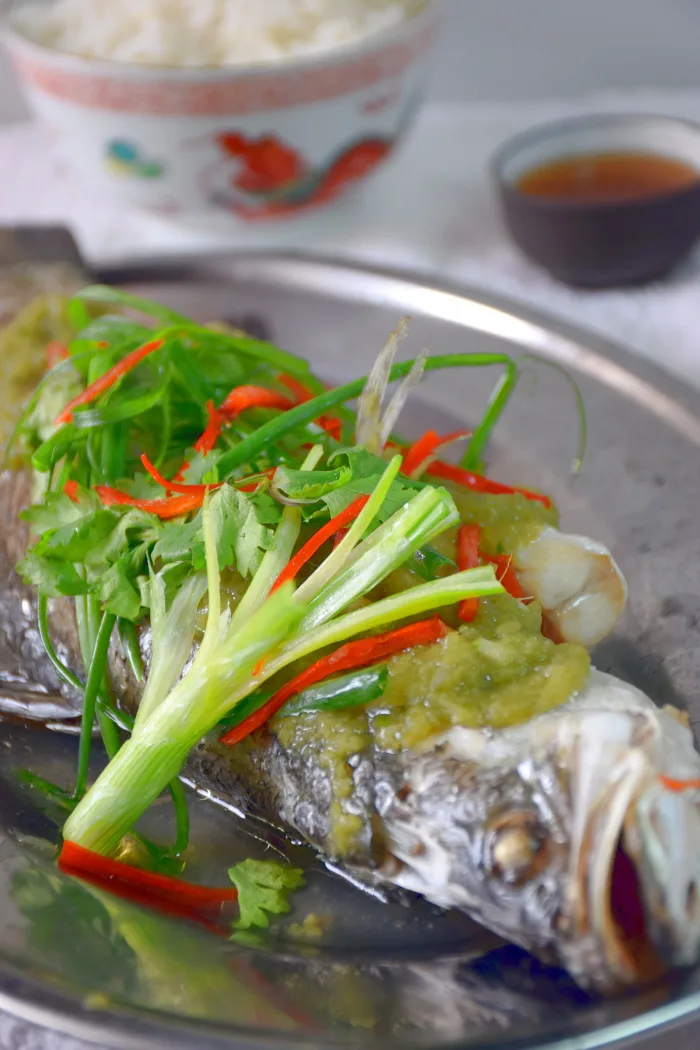
Four simple steamed fish tips that guarantee results
- The single most important factor to be successful in steamed fish is to use fresh fish. Live fish is the best. If it is not available, use freshly chilled fish. Reserve the frozen fish for frying or baking.- The timing of steaming is crucial for the best result. It is also the secret of the chef. The timing depends on a variety of factors:
– The intensity of the heat
– The weight of the fish
– The thickness of the flesh
– Whether the fish at room temperature or fresh from the chiller
– Whether you use a metal plate (good heat conductor) or a ceramic plate - Therefore, it is not possible to standardize the exact timing. As a general guideline, it takes 8 minutes to steam a fish weighed 600 to 800g, and 10 minutes for 800 to 1 kg).
- I regularly use a kitchen thermometer to ensure the fish is just cooked, but not overly done. It should be just right when you insert the kitchen thermometer to the thickest part of the flesh and get a reading of 140°F/60°C. When it reaches this temperature, stop steaming and remove it from heat immediately.
- It is pertinent to use premier grade soy sauce to make the sauce. You want to taste the flavor of the fish, not the sauce. Therefore the sauce should only play a supporting role in this recipe- not too strong and overpowering.
Chinese steamed fish has an unsurpassed nutrition value
We all know that fish contain an abundance of omega-3, which is heart-protective and reduces our bad cholesterol. However, high heat such as frying and canning can destroy omega-3 and other vitamins. Steaming is one of the best ways to preserve all the nutrition as steam is always at 100°C, no matter how long and how high you heat the water.
Four simple tips to confirm you have chosen the freshest fish
As I said, we only seasoned the steamed fish lightly to let the flavor of the fish stands out. Therefore, the freshness of the fish is the single most crucial point to the success of this dish. You can use a few tips to get the freshest fish from the market without fail. Here are the tips:
- Bright and clear eyes. The eyes are like the crystal ball, accurately predict how fresh the fish is.
- Shining, clean and metallic-like skin. These are signs of fresh fish.
- Bright red gills. The color will turn to the color of faded brick as time passes.
- Free from any smell. This is the most reliable method by far. Sea water fishes should have no fishiness smell. Freshwater fishes should be free from muddiness smell. Under no circumstances should you choose a stench fish.
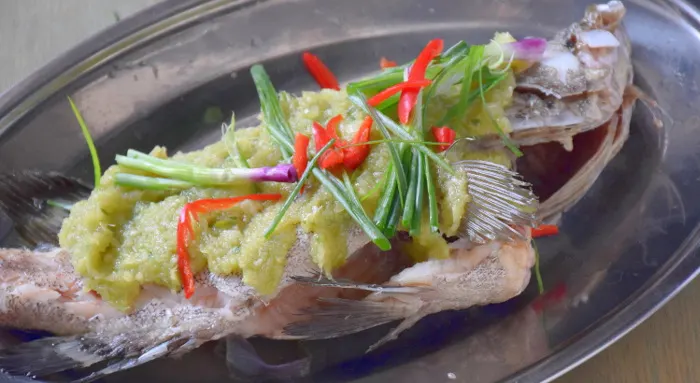

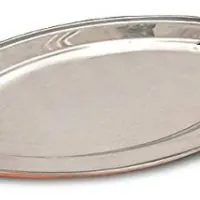
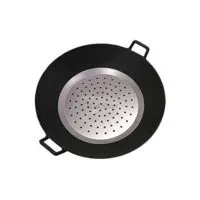
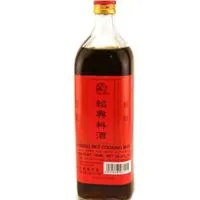
Ginger Scallion Fish- Easy Cantonese fried fish recipe
Saturday 17th of May 2025
[…] Traditional Cantonese steamed fish […]
Teochew-style steamed fish recipe (How to prepare)
Friday 22nd of November 2024
[…] Traditional Cantonese-style steamed fish with light soy sauce […]
Reynard
Thursday 7th of November 2024
Hi Can I use mackerel?
KP Kwan
Friday 8th of November 2024
You can use any fish for this recipe.
Chinese baked fish (with an amazing Asian fish sauce)
Wednesday 16th of October 2024
[…] Traditional Chinese steamed fish: Try this steamed whole fish recipe from our sister food blog, Taste of Asian Food. […]
Ken Lichtsinn
Saturday 14th of March 2020
One of the ingredients is "red chili". Would that be a sweet red chili like a red bell pepper or a spicy (hot) red pepper?
KP Kwan
Saturday 14th of March 2020
Hi Ken, The red chilies we used here are those type that is the long and. I think that is called Serrano chili. I am not using the red bell pepper. KP Kwan